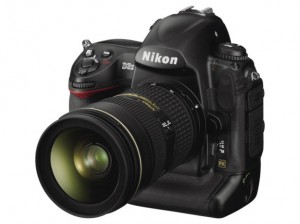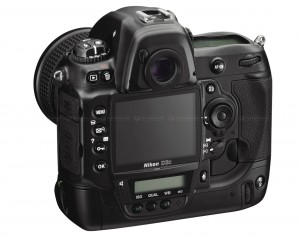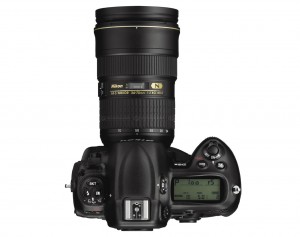Nikon D3X
Nikon has introduced its new top-of-the-range D-SLR, the D3X. Building on the reliability, handling and durability of the award-winning D3, the D3X offers an imaging sensor with far higher resolution than its counterpart, breaking new ground in imaging quality. The all-new 24.5MP CMOS sensor makes the new camera eminently suitable for the broadest range of shooting situations, both in the studio and on location, and will be especially appreciated by uncompromising photographers in nature photography, studio work and fashion.

The D3X has a specially-developed FX-format CMOS image sensor with 12-channel readout, gapless micro lens array and an on-chip noise reduction. It delivers class-leading levels of continuous shooting speed and noise management at higher sensitivities without sacrificing detail.
Nikon FX-format CMOS sensor with 24.5 megapixels
The D3X employs a new Nikon FX-format CMOS sensor with 24.5 effective megapixels covering an area of 35.9 x 24.0 mm to achieve truly amazing resolution. What’s more, we’ve optimized the pixel characteristics to provide a higher S/N ratio and wider dynamic range by securing a greater amount of light received by each pixel, thereby reducing lost highlights and shadows, and ensuring smoother tone reproduction with minimized noise.
Wide sensitivity range starting at ISO 100
At normal setting, the D3X offers a wide range of sensitivity — from ISO 100, suitable for stroboscopic setting in studio shoots, to ISO 1600. It realizes superior image quality with less noise at ISO 1600 as well as at low sensitivity settings. What’s more, the sensitivity range can be increased by two stops (up to ISO 6400 equivalent) and decreased by one stop (down to ISO 50 equivalent), offering an even greater diversity of shooting possibilities. Auto sensitivity control is also available.
New EXPEED-based image processing
A new image processing system, based on Nikon’s comprehensive EXPEED digital image processing and specially optimized for the D3X, provides superior image quality, faster processing speeds and lower power consumption. This advanced system achieves precise color reproduction for the broadest spectrum of hues, plus vivid saturation and smooth gradation, conveying colors as you see them, even with the slight changes in color tones you perceive. Furthermore, Nikon’s advanced noise processing function, which was designed to minimize noise occurrence, achieves this without interfering with other factors, including hue.
High-speed performance meets the most rigorous professional demands
Just like the D3, the D3X achieves a start-up time of 0.12 second and a shutter release time lag of 0.04 second*1*2. It delivers a continuous shooting speed of approx. 5 frames per second in FX format (36 x 24) or 5:4 (30 x 24), and 7 frames per second in DX format (24 x 16)*2*3. Also, the D3X is fully compatible with UDMA, the new-generation high-speed card that enables 35-Mbyte recording equivalent to the D3. The D3X is capable of recording approx. 7.1 MB (JPEG, image size L, NORMAL) of data captured in FX format at speeds of approx. 5 frames per second.
Realizing reliable auto control: Scene Recognition System
As with the D3, the D3X recognizes subjects and shooting scenes using a 1,005-pixel RGB sensor that precisely controls exposure by detecting not only the brightness but the colors of the subjects as well. The results are applied to control Autofocus, Auto Exposure, i-TTL Balanced Fill-flash and Auto White Balance, thereby achieving control of the highest.
AF system employing high-density 51-point AF
The Multi-CAM 3500FX autofocus sensor module, originally incorporated in the D3, offers proven outstanding performance. All 51 focus points, including the 15 cross-type sensors located at the center, are effective in all AF NIKKOR lenses with a maximum aperture of f/5.6 or larger. Three AF-area modes — Single point, Dynamic-area AF and Auto-area AF — are available to maximize the use of the 51 focus points by selecting the most suitable one to match subject conditions. Moreover, in Scene Recognition System, subject identification and tracking information is applied to improve subject acquisition performance in Dynamic-area AF mode and focusing accuracy for human subjects in Auto-area AF mode.
Superior durability
Magnesium alloy is used for the exterior cover, chassis and mirror box to ensure light weight and rugged reliability. Strict O-ring sealing at critical connected parts effectively restricts dust and moisture.
The shutter unit, developed and manufactured by Nikon, employs a new material (carbon fiber/Kevlar® hybrid) for the shutter blades, guaranteeing excellent durability through 300,000-cycle release tests with the shutter actually loaded. Precision is also maintained with a shutter monitor.
High-resolution 3-inch LCD monitor with approx. 920k-dots (VGA), 170° wide-viewing angle and reinforced glass
The D3X incorporates a large, 3-inch LCD monitor with ultra-high resolution of approx. 920k-dots (VGA). Enlarged playback images also appear in extremely high resolution for easy focus confirmation. The wide viewing angle of 170° makes it easy to check composition in Live View shooting for both high and low angles.

Two Live View modes available
In Handheld mode, which allows the frame to be recomposed prior to actual shooting, ordinary TTL phase-difference AF using all 51 AF points is activated. Tripod mode is designed for precise focus with still subjects and tripod stabilization; It allows focal-plane contrast AF on a desired point within a specific area. Optional software Camera Control Pro 2 enables monitor focus and control shutter release from a computer. And optical Wireless Transmitter WT-4 enables wireless remote camera control and image transfer.
Picture Control System
Picture Control System offers four kinds of Picture Controls: Standard, Neutral, Vivid, and Monochrome. Choose one and use as is, or adjust image creation factors (Sharpening, Contrast, Brightness, Saturation, and Hue). Optional Picture Controls (Portrait, Landscape, D2XMODE I, D2XMODE II and D2XMODE III) are available at the Nikon website for downloading and installation to your camera.
Active D-Lighting — reproducing brightness as you see it
In settings with strong contrast, Active D-Lighting, used in combination with 3D Matrix Metering II, determines an exposure by utilizing a gradation of highlights, detects lost shadows, then reproduces them after digital processing. Rather than simply expanding the dynamic range, Active D-Lighting prevents images from looking flat through localized tone control technology, and creates realistic contrast while compensating lost shadows and highlights. Choose from Auto, Extra High, High, Normal, Low or Off setting prior to shooting.
Electronic virtual horizon
An accelerator sensor incorporated in the body of the camera detects inclination and displays it in the LCD monitor. In Live View shooting, virtual horizon is displayed in the LCD above the monitor image. It can also be displayed in the top control panel and in the exposure indicator of the viewfinder.
UDMA-compatible memory card double slot
The CompactFlash (CF) card slots are UDMA-compatible for high-speed data transfer. With the double slot, you can choose from Continuous recording, Backup recording, and RAW + JPEG Separation recording (records the same image in RAW and JPEG on different cards). You can also copy the data from one card to another.

GPS Unit GP-1 (optional)GPS records shooting information such as latitude, longitude, altitude and date of shooting. Coordinated with map information, you can create an original map using images.
Nikon D3x Technical specifications
| Sensor | • 35.9 x 24 mm CMOS sensor • FX format • RGB Color Filter Array • Built-in fixed low-pass filter • 25.72 million total pixels • 24.5 million effective pixels • 3:2 aspect ratio |
|---|---|
| Image processor | Nikon EXPEED |
| Price | • $7999 • €7728 • £5499 |
| Image sizes (FX format) | • 6048 x 4032 [L] • 4544 x 3024 [M] • 3024 x 2016 [S] |
| Image sizes (DX format) | • 3968 x 2640 [L] • 2976 x 1976 [M] • 1984 x 1320 [S] |
| Image sizes (5:4 format) | • 5056 x 4032 [L] • 3792 x 3024 [M] • 2528 x 2016 [S] |
| File formats | • NEF (12-bit or 14-bit, compressed or lossless compressed RAW) • NEF + JPEG • TIFF • JPEG (EXIF 2.21) |
| Lens mount | • Nikon F mount with AF coupling and AF contacts • No field of view crop (full-frame) • When using DX lenses / DX mode 1.5x FOV crop |
| Usable lenses | • Type G or D AF NIKKOR: All functions supported • DX AF NIKKOR: All functions supported except FX-format (36×24)/5:4 (30×24) image size • AF NIKKOR other than type G or D: All functions supported except 3D Color Matrix Metering II • AI-P NIKKOR: All functions supported except autofocus and 3D Color Matrix Metering II • Non-CPU AI NIKKOR: Can be used in exposure modes A and M; electronic rangefinder can be used if maximum aperture is f/5.6 or faster; Color Matrix Metering and aperture value display supported if user provides lens data * IX NIKKOR lenses cannot be used * Excluding lenses for F3AF |
| Auto Focus | • 51 focus points (15 cross-type sensors) • Multi-CAM 3500FX • AF working range: -1 to +19 EV (ISO 100, normal temperature) • Contrast Detect in Live View (Tripod) mode |
| AF Area Mode | • Single point AF • Dynamic Area AF [9 points, 21 points, 51 points, 51 points (3D-tracking)] • Automatic-area AF |
| Focus Lock | Focus can be locked by pressing shutter-release button halfway (single-servo AF) or by pressing AE-L/AF-L button |
| AF assist | External Speedlite only |
| Exposure modes | • Program Auto [P] with flexible program • Shutter-Priority Auto [S] • Aperture-Priority Auto [A] • Manual [M] |
| Metering | TTL full-aperture exposure metering using 1005-pixel RGB sensor |
| Metering range | • 3D Color Matrix Metering: 0 to 20 EV • Center-Weighted Metering: 0 to 20 EV • Spot Metering: 2 to 20 EV • At normal temperature (20°C/68°F), ISO 100 equivalent, f/1.4 lens |
| Meter coupling | CPU and AI |
| Exposure lock | Locked using AE-L/AF-L button |
| Exposure bracketing | • 2 to 9 frames • 1/3, 1/2, 2/3 or 1 EV steps |
| Exposure compen. | • +/-5.0 EV • 1/3, 1/2 or 1 EV steps |
| Sensitivity | • Default: ISO 100 – 1600 in 1/3, 1/2 or 1.0 EV steps • Boost: 50 – 6400 in 1/3, 1/2 or 1.0 EV steps, HI2 = ISO 6400 |
| Shutter | • Electronically-controlled vertical-travel focal plane shutter • 30 to 1/8000 sec (1/3, 1/2 or 1.0 EV steps) • Flash X-Sync: 1/250 sec • Bulb |
| DOF Preview | • Stop-down lens aperture by pressing button • Activates modeling flash |
| White balance | • Auto (1005-pixel CCD, image sensor) • Presets (seven) with fine tuning • Manual presets (four) • Color temperature in Kelvin (2500 – 10000 K, 31 steps) • White balance bracketing (2 to 9 frames, 10,20,30 MIRED steps) |
| Picture Control | • Standard • Neutral • Vivid • Monochrome |
| Image parameters | • Sharpening: Auto, 7 levels • Contrast: Auto, 5 levels, Custom tone curve • Brightness: 3 levels • Saturation: Auto, 5 levels • Hue: 5 levels |
| Color space | • sRGB (Standard and Vivid modes) • Adobe RGB (Neutral mode) |
| Viewfinder | • Optical-type fixed eye-level pentaprism • Built-in diopter adjustment (-3 to +1m-1) • Eyepoint: 18 mm (at -1.0m-1) • Focusing screen: Type B BriteView Clear Matte VI screen • Frame coverage 100% • Viewfinder magnification approx 0.7x with 50 mm f/1.4 lens |
| Focusing screen | • B-type BrightView Clear Matte Screen II • Superimposed focus brackets • On-demand grid lines |
| LCD monitor | • 3.0 ” TFT LCD • 922,000 pixels (VGA; 640 x 480 x 3 colors) • 170° viewing angle • Brightness adjustment |
| LCD Liveview | • Handheld mode: TLL phase-difference AF with 51 focus areas (15 cross-type sensors) • Tripod mode: focal-plane contrast AF on a desired point within a specific area |
| Shooting modes | • Single frame • Continuous Low [CL]: 1 – 5 fps • Continuous High [CH]: 5 fps (5-7 fps with DX format) • Liveview [LV] • Self-Timer (programmable) • Mirror-up mode |
| Continuous buffer | • JPEG Large/Normal: no data yet • RAW: no data yet |
| Self-timer | • 2 to 20 sec custom |
| Flash control | •TTL flash control with 1,005-pixel RGB sensor; i-TTL balanced fill-flash and standard i-TTL fill-flash available with SB-800, 600 or 400 • AA (Auto Aperture-type) flash: Available with SB-800 used with CPU lens • Non-TTL Auto: Available with Speedlights such as SB-800, 28, 27, and 22S • Range-priority manual flash; available with SB-800 |
| Flash Sync Mode | • Front-curtain Sync (normal) • Red-Eye Reduction • Red-Eye Reduction with Slow Sync • Slow Sync • Rear-curtain Sync |
| Flash compensation | • -3 to +1 EV • 1/3, 1/2 or 1 EV steps |
| Orientation sensor | Tags images with camera orientation |
| Playback mode | • Full frame • Thumbnail (4 or 9 images) • One-touch zoom • Slideshow • RGB histogram • Shooting data • Highlight point • Auto image rotation |
| Languages | • Chinese (Simplified and Traditional) |
| Custom functions | 48 custom functions |
| Connectivity | • USB 2.0 (Hi-Speed) Mini-B connector • HDMI video out (version 1.3a, Type A connector) • Remote control 10-pin terminal • PC Sync flash terminal |
| 10-pin terminal | • GPS: NMEA 0183 (Ver. 2.01 and 3.01) interface standard supported with 9-pin D-sub cable and GPS Cable MC-35 (optional) |
| Communications | FTP and PTP/IP file transfer with optional Wireless Transmitter WT-3 (IEEE 802.11 b/g) |
| Storage | • Dual Compact Flash Type I or II • UDMA, Microdrive and FAT32 supported • 36 characters of text can be input and stored in EXIF header |
| Power | • Lithium-Ion EN-EL4a/EL4 • Included dual battery charger MH-22 • Optional AC adapter EH-6 |
| Dimensions | 160 x 157 x 88 mm (6.3 x 6.2 x 3.4 in) |
| Weight (no batt) | 1220 g (2.11 lb) |
Comments Leave a Comment
Comments are closed.

prices may please be given.